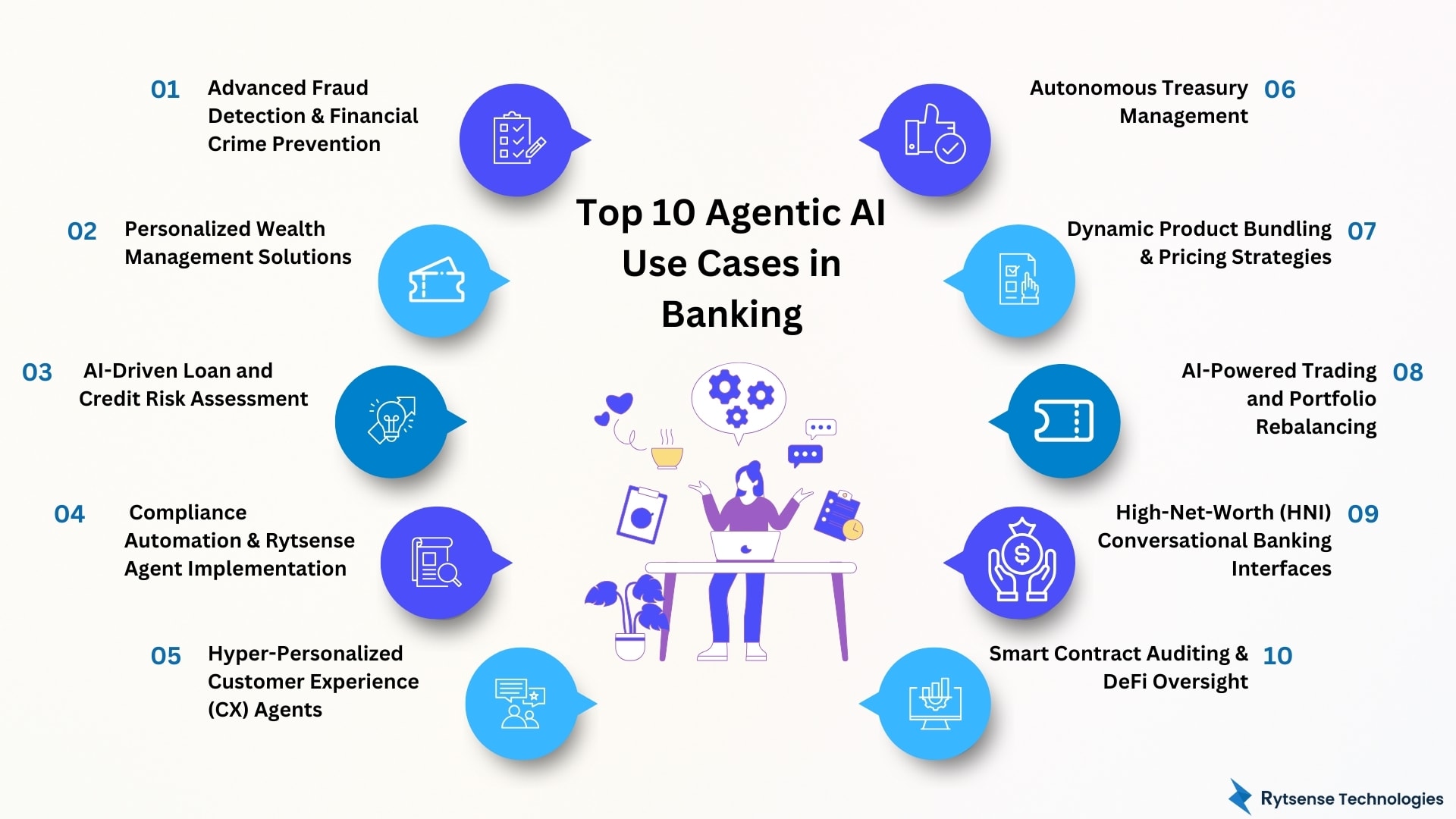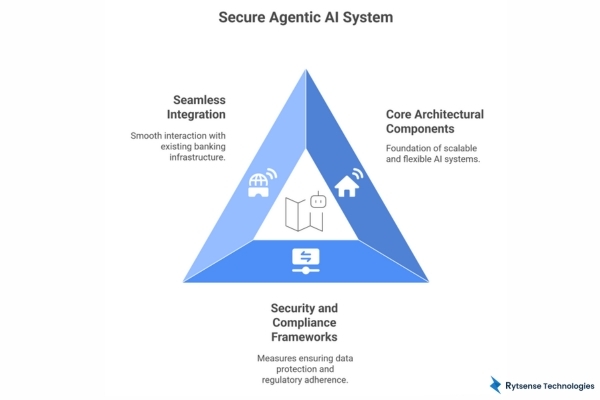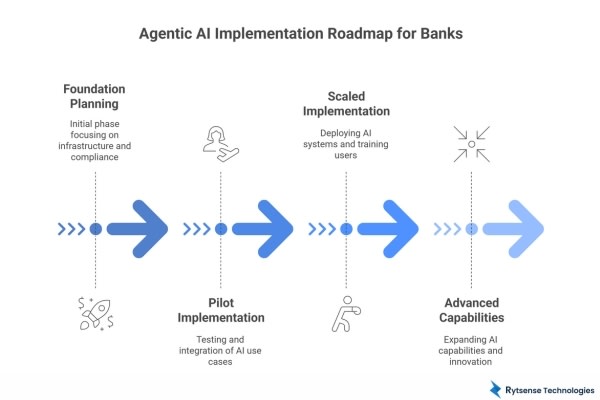-
Key Takeaways
- Seventy percent of banking leaders are already leveraging agentic AI in terms of implementations and pilots, anticipating a $1 trillion yearly valuation by the year 2030.
- Upon implementing AI automation, banks will see a 3.5x return on investment in 18 months or less
- Compliance processes will experience on average an 85-99% reduction in time.
- The agentic AI technology transforms banking operations from reactive to proactive, predicting issues and optimizing processes in real-time data.
- The AI systems will reduce false positives by 70% on average while improving fraud detection efficacy by 6-10% across large financial institutions.
Top 10 Agentic AI Use Cases in Banking
The world over, Agentic AI use cases in banking institutions show change. A study of 250 Bank Executives in 2025 found that 70% of leaders said that their institutions use some form of agentic AI, with 16% actively deploying it and 52% piloting AI projects. By 2030, AI is predicted to generate as much as $1 trillion in annual value for global banking institutions, with over 60% of Banking Executives deploying AI across key business operations. Banks continue to report a return on investment (ROI) averaging 3.5x within eighteen months, on AI solutions focused on process improvement.
From Reactive to Proactive: Unlocking the Strategic Potential of Agentic AI
Agentic AI use cases in banking identify independently, translates learning from patterns and behaviors through time, and informs appropriate decisions both effectively and efficiently with no human involvement. Most importantly, agentic banks predict the outcome before a problem occurs. The shift from being simply reactive to being proactive opens up unprecedented opportunities.
The emergence of banking AI solutions means that the service is now being deployed to analyze client behavior using real-time data. Banking AI technology can identify issues before the client acknowledges that a problem exists. Banking AI can make product suggestions based on life events or automatically optimize the financial operation. Reactivity is no longer the strategic variable, but a use of Agentic AI can provide unprecedented competitive advantages.
Transform your bank from reactive to proactive with AI-driven intelligence. Discover how agentic AI can reshape your customer experience and operational agility.
Capabilities of Proactive Agentic Systems
These systems observe multiple data streams in parallel. They associate data from diverse data touchpoints. They continuously create insights. They take actions based on pre-programmed goals. They optimize processes in real time.
AI-driven banking services operate 24/7 at this point without human supervision. They facilitate routine tasks efficiently. They escalate complex transactions in appropriate ways. They operate with consistency in service quality. They generate significant operational cost savings.
| Capability | Traditional Systems | Agentic AI Systems |
|---|---|---|
| Response Time | Hours to Days | Real-time |
| Decision Making | Rule-based | Context-aware |
| Learning | Static | Continuous |
| Scalability | Limited | Infinite |
| Personalization | Basic | Hyper-personalized |
Deliver banking experiences your customers will love. Build intelligent CX agents that understand intent, emotion, and behavior in real-time.
Top 10 Agentic AI Use Cases in Banking

1. Advanced Fraud Detection & Financial Crime Prevention
Top banks utilizing AI systems have reported dramatic reductions in false positive rates, with numbers in the 70% range. For example, American Express increased fraud detection by 6% utilizing an advanced LSTM AI model, while Paypal experienced a 10% efficiency increase across a global environment using AI systems.
Agentic AI systems continuously monitor behavioral patterns. They can instantly detect unusual spending behaviors outside of expectations. They can alert humans to questionable transactions. They can also flag fraudulent transactions and block payments in real-time. They learn from every new fraud scheme as soon as the model is trained.
Agentic AI systems stem the flow of digital and physical currencies today by analyzing and providing support. They analyze device fingerprints, location data, and transactional histories. They can also gather and synthesize information from diverse sources, often co-relating information on fraud rings that operate across institutions. They can also proactively prevent anti money-laundering schemes.
Key Benefits
- Real-time fraud prevention
- Reduced false positives
- Enhanced customer experience
- Compliance automation
- Efficiency-induced cost reduction
2. Personalized Wealth Management Solutions
Intelligent banking agents continuously evaluate market conditions. They will automatically make trades based on predetermined actions or strategies. The agents track economic indicators and conditions continuously on a worldwide basis.
These systems assess and analyze client wealth and personal financial goals and situations. The AI will also account for life events and changing circumstances. Personalized investment recommendations are generated while adjusting strategies based on performance metrics as well.
For Example, JPMorgan Chase's AI-powered wealth management platform autonomously rebalances the portfolio of its clients based on market fluctuations and risk tolerance. When a client approaches retirement, the AI will automatically pivot the client's portfolio from growth equities to conservative bonds in a gradual manner without any human intervention. At the same time, the AI is continuously monitoring the state of the global economy in terms of economic indicators in the given user's investment philosophy and risk profile in an effort to allocate assets and maximize returns within their risk tolerances.
Implementation features include:
- Automated portfolio rebalancing
- Continuous risk assessment algorithms
- Market trend analysis
- Tax strategy & optimization
- Performance tracking dashboard
3. AI-Driven Loan and Credit Risk Assessment
These agentic systems analyze factors such as social media, spending activity, and employment history. They analyze cash flow patterns that derive from bank statements. They assess payments across several accounts. In aggregate, they provide an accurate, verifiable estimate of default probability.
AI models assess thousands of features simultaneously. They spot subtle signals of risk. They adjust to economic conditions. They provide rationales to explain the reasoning behind the decision. They support fair lending practices.
For example, Wells Fargo has implemented an AI-based credit assessment system that evaluates over 3,000 separate data points, namely transaction patterns, timing of bill payments, and merchant categories, in under 60 seconds to assess loan applications. The system data showed that customers who always pay their utility bills early have a 40% lower default rate. It allows the bank to approve applications that would otherwise be denied, keeping the bank's risk profile the same and increasing lending to underserved borrowers.
Assessment Features:
- Analysis of income stability
- Analysis of debt-to-income ratio
- Analysis of payment history
- Alternative credit data
- Behavioral assessment
4. Compliance Automation & Rytsense Agent Implementation
A human practitioner can typically supervise 20 or more AI agent workers at once for productivity gains from 200 to 2,000 percent. This has been especially transformative in KYC/AML processes.
Agentic compliance systems monitor transactions for suspicious behavior, generate regulatory reports automatically, and thoroughly maintain audit trails, flagging potential violations immediately.
Agentic compliance systems analyze customer documentation independently, verify identity information across databases, monitor changes in beneficial ownership, and automatically update for changes in sanctions list.
For Example, HSBC has an AI-driven compliance system that handles over 30 million transactions a day, automatically flagging suspicious behavior and decreasing false positive alerts by 50 percent. When new sanctions are imposed on individuals or organizations, the system automatically screens all customer databases, freezing those accounts that meet the conditions in a matter of minutes. The AI agents also generated 85 percent fewer cases for manual review and maintained 99.7 percent accuracy in detection of suspicious behavior under money laundering laws.
| Compliance Area | Manual Process Time | AI-Automated Time | Efficiency Gain |
|---|---|---|---|
| KYC Onboarding | 2-5 days | 10-30 minutes | 95% reduction |
| AML Monitoring | 4-8 hours | 5-15 minutes | 90% reduction |
| Regulatory Reporting | 1-2 weeks | 2-4 hours | 85% reduction |
| Sanctions Screening | 30-60 minutes | 2-5 seconds | 99% reduction |
Also Read:
Use cases of AI chatbot in businesses5. Hyper-Personalized Customer Experience (CX) Agents
These agents use AI to analyze and interpret comprehensive historical data of customer interactions. They predict appropriate service intent before the customer sees the need. They present relevant and timely products. They are aware of the context of the conversation across multiple channels.
Intelligent banking solutions incorporate a multi-channel solution for voice, chat and visual interfaces. They solve complex inquiries without human involvement. They escalate appropriately when needed. They continue to learn and grow from every interaction.
For example, Bank of America's virtual assistant Erica handles more than one billion customer interactions a year providing personalized financial advice through customer activities and transaction history. When the customer's mortgage payment is due, Erica will proactively remind customers and offer to schedule their payments to be automatic. In voice interactions, the AI identifies an emotional cue, and when a customer sounds frustrated, the AI system will automatically transfer it to a human agent. When a customer reaches a financial milestone, Erica replies with a congratulatory message and recommends relevant products.
Personalization Features:
- Contextual flow of conversation
- Predictive service implications
- Consistency across channels
- Recognition of emotional intelligence
- Proactively resolving issues
6. Autonomous Treasury Management
Automated financial systems evaluate market conditions live. They forecast cash requirements accurately. They automatically optimize investment selection. They proactively manage counterparty risk.
AI agents coordinate with multiple bank partners at once. They automatically negotiate rates. They execute trades at the most opportune time. They consistently maintain regulatory capital requirements.
For example, Goldman Sachs has an autonomous treasury system that oversees more than $400 billion in daily liquidity around the world markets, which autonomously executes currency hedge positions when the foreign exchange rates exceed pre-defined levels. The AI system predicted a cash shortage three days before it happened, subsequently autonomously securing $2 billion in overnight funding at the best rate while preparing the investment portfolio to meet the regulatory capital ratios, all without human intervention. In total, the money saved the bank $15 million in funding costs on an annual basis.
Treasury functions:
- Automation of liquidity management
- Hedging of interest rate risk
- Optimization of foreign exchange
- Management of investment portfolio
- Optimization of regulatory capital
7. Dynamic Product Bundling & Pricing Strategies
These systems correlate the patterns of product use with customer characteristics in order to predict needs. They dynamically personalize features of products and adjust pricing based on market conditions.
Intelligent agents continuously analyze competitor pricing and optimize margins simply while capturing business. They personalize proposals based on value and test automatic pricing decisions.
For example, a customer recently purchased a house based on their mortgage inquiries and spending at home improvement stores, and Citibank's AI-powered bundling system was able to detect this and automatically create a personalized "New Homeowner Bundle." The New Homeowner Bundle offered a home equity line of credit with a 0.25% discount, premium checking with no monthly fee, and a cash back credit card with bonus points for home improvement purchasing. The targeting increased product adoption by 45% and brought $3.2 million in additional quarterly revenue.
- Recommendations based on life-event
- Analysis of Usage patterns
- Competitive pricing optimization
- Customer value assessment
- Revenue maximization algorithms
8. AI-Powered Trading and Portfolio Rebalancing
AI trading agents will conduct exploration of market data in real-time from multiple sources, identifying arbitrage opportunities in nanoseconds, executing high-frequency trades, and adjusting in real time to volatile market conditions.
These systems will be able to continuously monitor economic indicators; they will assess the geopolitical landscape for risk and automatically adapt trade tactics based on market conditions, adjusting portfolios as levels of volatility dictate.
For example, Morgan Stanley's artificial intelligence trading infrastructure collects more than 50 billion data points each day and carries out 85% of equity trades without human intervention. When the markets became volatile in 2024, the AI system was able to identify emerging geopolitical tensions through news sentiment analysis and automatically rebalance $120 billion of client portfolios within 30 minutes, reducing portfolio risk by 15%, while maintaining target returns. The AI system also identified arbitrage opportunities across 12 global exchanges that produced an additional $45 million in trading profits per quarter.
- Continuous market analysis
- Trade execution automation
- Management of risk protocols
- Performance optimization
- Regulation compliance monitoring
9. High-Net-Worth (HNI) Conversational Banking Interfaces
Conversational banking interfaces for HNI clients can integrate multiple asset classes. They can provide a comprehensive view of a client's portfolio in a single view and facilitate complex transactions seamlessly. They will also provide considerable privacy and security.
Conversational banking agents can handle complex queries naturally and on behalf of HNI clients. They connect to relationship managers seamlessly, developing insights about the market as they proactively create a path for execution. They can process transactions accurately and provide up-to-date commentary when executing specific tasks.
For example, UBS has created an AI-enabled wealth management platform for ultra-high-net-worth clients with portfolios greater than $50 million that allow each client to make recommendations through natural language commands. In response to the command, "I want to reduce my tech exposure before earnings season," the AI system analyzes the client's portfolio of $200 million, identifies overweight holdings in technology stocks, and simultaneously executes a coordinated sale across 15 asset classes leveraging tax efficiency. The AI system coordinates with the client's relationship manager and tax advisor, and completes the rebalancing in less than 24 hours while maintaining the client’s privacy through secure, encrypted communications.
- Multi-asset portfolio management
- Private banking
- Personal insights of the market
- Secure transactions
- Relationship manager connection
10. Smart Contract Auditing & DeFi Oversight
These systems will monitor smart contract code for vulnerabilities. They will track token transfers across protocols. They will analyze counterparty risks in a DeFi transaction. They will also automatically monitor compliance with regulations.
Agentic AI will bridge traditional banks to the DeFi ecosystem, enabling them to safely participate in decentralized protocols. It will track and maintain compliance with regulations. And it will proactively protect institutional investments.
For example, JPMorgan's division that investigates blockchain technology regularly utilizes AI to track a total of $2.8 billion in institutional DeFi investments while scanning over 500 smart contracts on a daily basis for security issues. When it sensed a potential exploit in the yield farming protocol, the AI withdrew $150 million in clients' funds two days prior to a hack that would have cost them all the money, therefore preventing risk of loss. The division also has the capability to ensure compliance with relevant financial regulations. While flagging any activity that would be potentially non-compliant with banking regulations in the various jurisdictions in which it operates.
- Smart contract vulnerability analysis
- DeFi protocol risk monitoring
- DeFi regulatory compliance monitoring
- Cross-chain transaction monitoring
- Integration with institutional custodians
Overcome regulatory, data, and talent challenges with a trusted AI partner experienced in enterprise-scale implementation.
Driving Tangible Business Value Through Agentic AI in Banking
The agentic AI use cases in banking also offers significant reductions in ongoing service operations cost. Agentic AI will automate routine processes without the need for manual intervention. These systems will consistently eliminate human error. They will provide a pathway and scale operations without a corresponding increase in staffing needs. These systems will optimize, or re-optimize, ongoing needs for data based service while meeting evolving user service requirements.
At the revenue enhancement level, AI systems will efficiently increase user satisfaction with service. These systems will increase the human interaction success rate for cross-selling. These systems will effectively reduce user churn meaningfully. They will provide a way to offer premium services to clients. They will enable enterprises to offer anything.
Then there is the risk mitigation aspect defined as the early detection within agentic AI. AI can help detect threats earlier. AI can threaten the user experience with rigorous prevention of loss. AI can ensure compliance automatically. Further, AI can ensure operational resilience.
The agentic AI system is the last value creation area, described earlier.
- Cost optimization through automation
- Revenue optimization through personalization
- Risk optimization through early detection
- Operational efficiency
- Customer satisfaction
Essential Features of a Secure and Scalable Agentic AI System

Core Architectural Components
The management of data will form the basis of the system. AI agents will require access to data and information in real-time. AI agents will need historical data in order to apply past behaviours to future actions. AI agents must ensure they review information as consistently as possible. AI agents must ensure they adhere to data governance.
Processing capability must be scalable in a dynamic manner. Systems handle workloads of varying sizes. They optimally distribute computing capabilities. They maintain consistent performance with data. They automatically provide fault tolerance.
Architectural Components:
- Microservices architecture
- Event-driven communication
- Real-time data streaming
- Distributed processing capabilities
- Fault tolerant design patterns
Security and Compliance Frameworks
Compliance frameworks ensure compliance with regulations. Systems create complete audit trails. Systems implement data privacy safeguards. Systems automate regulatory reporting. Systems dynamically accommodate changes in compliance requirements.
Identity and access management controls access points to the system. Multi-factor authentication is used to provide secure user access. System capabilities are properly limited by eligible user role permissions. Continuous monitoring for unauthorized activities is enabled in real-time.
Security Components:
- Multi-layered security architecture
- End-to-end encryption protocols
- Identity and access management
- Continuous monitoring systems
- Compliance automation tools
Seamless Integration with Legacy Banking Infrastructure
Integration techniques should minimize operational disruption. Phased-implementation approaches reduce risk. Running systems in parallel maintains business continuity. Rollback mechanisms provide a safety net.
Data synchronization maintains consistency across systems. Real-time data replication provides accuracy. Conflict resolution manages data discrepancies automatically. Performance monitoring highlights bottlenecks.
| Integration Aspect | Challenge | Solution |
|---|---|---|
| Data Format | Legacy system incompatibility | API translation layers |
| Real-time Processing | Batch-oriented systems | Event streaming architecture |
| Security | Different authentication methods | Unified identity management |
| Performance | System bottlenecks | Load balancing and caching |
Challenges in Deploying Agentic AI in Banking
Navigating Regulatory Requirements
The need for similar explainability requirements means that systems would explain their choices and provide a sufficiently coherent rationale for their actions. Agentic AI use cases in banking or the systems must offer adequate details in their actions to provide an audit trail as well as regularly re-evaluate their compliance requirements.
Regulatory bodies are consistently updating or modifying regulatory compliance or supervisor requirements. As the banking environment embraces AI technologies, AI systems must demonstrate the ability to quickly respond and adapt to new requirements. Compliance teams will need training and supervision in understanding AI systems and built-in safeguards. Risk assessment methodologies will also need to become nimble in adapting and implementing AI systems.
Key Regulatory Difficulties
- Multijurisdictional
- Explainability
- Audit Trail and Monitoring
- Regulatory evolution and continuous change
- Risk Assumption Adjustment
Addressing Data Quality Issues and Silos
Data silos lead to an inability to assess data from an overall view. Information silos stifle the true function of AI. Large organizations have other pressures not to share information across functions. Agentic AI use cases in banking and their Legacy systems only add further complications and barriers to data integration.
Data governance frameworks must gain traction across the enterprise. Clear data quality standards need to be consistently enforced. Data administration roles must be clearly defined. The practice of monitoring data quality should be engaged at all times.
Data issues:
- Inconsistent data quality standards
- Information silos among departments
- Data format from legacy system
- Real-time data synchronization
- Strong data governance solution
Overcoming Talent Shortages
Technical expertise involves a number of disciplines. AI expertise combined with banking domain knowledge. Integration skills to connect legacy systems to modern systems. Project management to manage implementation of complex implementations.
Talent development plans can help address a shortage of talent before it happens, by partnering with education institutions to pipelines of entry-level talents. Provide internal training and development programs to staff who can take on new roles. Leverage external consultants for immediate access to hard-to-find talent.
Talent Requirements:
- AI/ML engineering talent
- Banking domain knowledge
- Integration skills
- SOA and data science experience
- Project management experience
Managing Organizational and Cultural Resistance
Successful implementation depends on leadership alignment. Consolidated and continuous communication effectively addresses the concerns of employees. Training programs increase employee confidence in utilizing new systems successfully, both present and in the future. Showcasing success stories creates trust and excitement about value creation opportunities.
Change management strategies provide a coordinated and continuous approach to ongoing change implementation. Rolling implementation strategies limit process disruption. Engaging employees during change processes increases employee buy-in. Continuous feedback allows for better decision-making around adopting new processes and/or systems/tools.
Cultural Challenges:
- Change resistance
- Ownership of established processes
- Alignment of leadership
- Training and skill acquisition
- Change communication strategies
Implementation Roadmap: Preparing Banks for Agentic AI
Phase 1: Foundation Planning (Months 1-6)
- Data infrastructure review
- Existing legacy systems review
- Talent acquisition plan
- Regulatory compliance review
- Technology stack identification
Phase 2: Pilot Implementation (Months 7-12)
- Use case ranking
- Proof of concept built
- Security framework built
- Integrate with existing systems
- Measure effectiveness
Phase 3: Scaled Implementation (Months 13-18)
- Deploy production system
- User training plan
- Streamline processes
- Continuous monitoring of performance
- Continuous improvements
Phase 4: Advanced Capabilities (Months 19-24)
- Expansion of additional use case
- Implementing advanced AI capabilities
- Integrating across systems
- Enhancing predictive analytics capabilities
- Continuous innovation cycle
Successful implementation of Agentic AI use cases in banking will require an appropriate level of governance. An executive sponsor will ensure the deployment has the required level of resources for active deployment. Cross-functional team work will ensure the correct employee skills are used in an efficient manner. Frequent reviews of progress will ensure the initial momentum remains high.
- Executive leadership commitment
- Cross-functional team collaboration
- Agile development methodologies
- Continuous learning approaches
- Performance measurement frameworks

Why Partner with Rytsense Technologies for Building Agentic AI Solutions in Banking?
Technical expertise covers the entire AI development lifecycle. From initial strategy to deployment to ongoing maintenance, Rytsense provides full support. The agile development methodologies used at Rytsense accelerate time-to-market considerably.
Domain knowledge of banking ensures that custom AI solutions meet banking-specific needs. Regulatory compliance receives priority. Security implementation exceeds the standards and principles of the industry. Performance optimization leads to another level of measurable outcomes.
Benefits of Partnering with Rytsense Technologies
- Deep AI expertise in banking
- Regulatory compliance based approach
- Proven, methodologies to implement
- Knowledge of how to integrate within your legacy systems
- Ongoing support and maintenance
Services Include
- AI strategy development
- Custom agentic AI solutions
- Integration with legacy systems
- Regulatory compliance consulting
- Training and change management
Conclusion
The future of banking operations, services and trust will revolve around intelligent automation capabilities. Agentic AI systems will be integrated into the core operating systems of institutions. Financial institutions must prepare for this shift sooner than later. The time to act is now!
Agentic AI is redefining the future of banking. Don’t fall behind—empower your institution with next-generation intelligence.
Meet the Author

Karthikeyan
Connect on LinkedInCo-Founder, Rytsense Technologies
Karthik is the Co-Founder of Rytsense Technologies, where he leads cutting-edge projects at the intersection of Data Science and Generative AI. With nearly a decade of hands-on experience in data-driven innovation, he has helped businesses unlock value from complex data through advanced analytics, machine learning, and AI-powered solutions. Currently, his focus is on building next-generation Generative AI applications that are reshaping the way enterprises operate and scale. When not architecting AI systems, Karthik explores the evolving future of technology, where creativity meets intelligence.